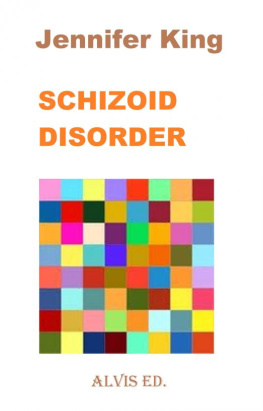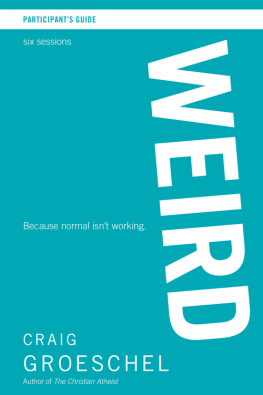Jennifer King - Schizoid Disorder
Here you can read online Jennifer King - Schizoid Disorder full text of the book (entire story) in english for free. Download pdf and epub, get meaning, cover and reviews about this ebook. year: 2012, publisher: ALVIS International Editions, genre: Home and family. Description of the work, (preface) as well as reviews are available. Best literature library LitArk.com created for fans of good reading and offers a wide selection of genres:
Romance novel
Science fiction
Adventure
Detective
Science
History
Home and family
Prose
Art
Politics
Computer
Non-fiction
Religion
Business
Children
Humor
Choose a favorite category and find really read worthwhile books. Enjoy immersion in the world of imagination, feel the emotions of the characters or learn something new for yourself, make an fascinating discovery.
- Book:Schizoid Disorder
- Author:
- Publisher:ALVIS International Editions
- Genre:
- Year:2012
- Rating:3 / 5
- Favourites:Add to favourites
- Your mark:
- 60
- 1
- 2
- 3
- 4
- 5
Schizoid Disorder: summary, description and annotation
We offer to read an annotation, description, summary or preface (depends on what the author of the book "Schizoid Disorder" wrote himself). If you haven't found the necessary information about the book — write in the comments, we will try to find it.
Schizoid Disorder — read online for free the complete book (whole text) full work
Below is the text of the book, divided by pages. System saving the place of the last page read, allows you to conveniently read the book "Schizoid Disorder" online for free, without having to search again every time where you left off. Put a bookmark, and you can go to the page where you finished reading at any time.
Font size:
Interval:
Bookmark:
Schizoid Disorder
Jennifer King
Copyright
Published by ALVIS Editions at Smashwords
2012 Alvis Ed.
ALL RIGHTS RESERVED
Smashwords License Notes
This e-book is licensed for your personalenjoyment only. This e-book may not be re-sold or given away toother people. If you would like to share this book with anotherperson, please purchase an additional copy for each recipient. Ifyou're reading this book and did not purchase it, or it was notpurchased for your use only, then please return to Smashwords.com and purchase your owncopy.
Thank you for respecting the work of thisauthor.
INDEX
SCHIZOID PERSONALITY DISORDER (SPD)
The schizoidsubjects are characterized by the fact that often live on themargins of society. Can be considered "misfits", "weird","touched", or simply be left alone to live a secluded and private.Their isolation may lead others to complain and try to establishcontact, but often these attempts fail and people traded afterbeing repeatedly rejected. They are often family members to pushfor the joint looking for help, worried, or exasperated by thebizarre behavior of the subject. Other times they are the subjectsthemselves to seek help, free choice, driven by their painfulsolitude. The inner world of the schizoid person, may differsignificantly from appearance outside of the individual.Undoubtedly these people are often a jumble of contradictions. Thescholar Akhtar (1987) has grouped these contradictions dividingthem into events discoveries and blankets. The schizoid individualis "manifestly" detached, self-sufficient, distracted,disinterested, asexual and radically moral, while "secretly" isextremely sensitive, emotionally needy, very attentive, creative,often perverse and corruptible. These polarities reflect and arethe expression of a division or fragmentation of the self indifferent representations of the self that are not integrated. Froma psychodynamic perspective, the designation "schizoid" reflectsthis fundamental splitting of the self. The result is a diffusionof identity - those schizoid do not know for sure who they are andfeel tormented by thoughts, feelings, desires and impulses stronglyconflicting. This identity diffusion, makes problematicinterpersonal relationships. In fact, the most specificcharacteristic of schizoid individuals is perhaps their apparentnot in relation to others. The psychoanalytic work indicates thatthese subjects undoubtedly nourish feelings and passions of others,but they are frozen on the evolutionary plan at an early stage ofthe relationship. These individuals seem to base their decision toremain isolated on the belief that their failure to get what theyneed from their mothers means that they can not in any way gropedto receive from other significant figures subsequentlyencountered.
According to theDSM IV (1994, p. 638), the essential feature of schizoid personality disorder is"a pervasive pattern of detachment from social relationships and arestricted range of expression of emotions in interpersonalsettings. These individuals seem to lack a desire of intimacy.Spend time alone and choose activities that do not includeinteraction with others. The ICD-10 (1994, p. 225) describes theschizoid personality disorder as "characterized by a retreat fromemotional contact, social and otherwise, with a preference forfantasy, solitary activities and introspection. They have a limitedability to express feelings and to experience pleasure. The subjectis characterized by a deficiency in the ability to experiencepleasure and is distinguished by the predominance of negativesymptoms associated with schizophrenia spectrum disorders, namelysocial deficits, interpersonal and affective psychotic-like withoutdistortion of cognitive / perceptual. The diagnosis of schizoidpersonality disorder should not be used if the pattern of behavioroccurs only during the course of schizophrenia and other psychoticdisorders or whether it is due to neurological conditions or othermedical conditions (DSM-IV , 1994, p. 639) . Individuals with SPDmay have particular difficulty expressing anger, even whenchallenged directly. Often react passively to adverse circumstancesand may not respond appropriately to major life events. Theseindividuals may have experienced some (minutes to hours) psychoticepisodes in response to stress. The SPD can be, but notnecessarily, a disorder prior to schizophrenia, major depression ordisorder of delirium. The most common personality disorders thataccompany the STP schizotypal personality disorders, paranoid andavoidant. The SPD is diagnosed more frequently in males that seemto be weaker for women compared to SPD (DSM-IV , 1994, p. 639).The SPD is not common in the clinical setting. It can be verydifficult to differentiate from autism or Asperger's syndrome. TheSPD differs from schizotypal personality disorder due to the lackof perceptual distortions. And 'different from paranoid personalitydisorder due to lack of suspiciousness and paranoid ideation(DSM-IV , 1994, p. 639-640). Individuals with schizoid personalitydisorder are seen as loners who are proud independence, lonelinessand social freedom. There is, however, dispute with respect to thefact whether the retreat with respect to the other is chosen fromthem or if it is generated from interpersonal anxiety. People withSPD recognize their differences from others, and life passes by andsee themselves as people who "lose their buses" merely observe lifefrom a distance. The schizoid personality disorder is currentlydefined by the lack of affection, inability to experience pleasureand low involvement with others. Individuals with avoidantpersonality disorder can control the affection, withdraw frompleasurable activities and avoid others in the name of themanagement of anxiety. Both can seek isolation, but individualswith schizoid personality disorder will be able to tolerate theseparation with the comfort and individuals with avoidantpersonality disorder are desperate and alone. Individuals withschizoid personality disorder not indicate dissatisfaction withisolation. It would seem that the clinical point of view there is asupport for this hypothesis. Individuals with schizoid personalitydisorder rarely seek treatment, individuals with avoidantpersonality disorder often do.
Much of ourunderstanding of the inner world of the schizoid subject comes fromthe work of the British object relations theorists. According toBalint (1968), in these patients there is a "fundamental flaw" inthe ability to relate caused by a significant inadequacy ofmaternal care received in childhood. He believed that thedifficulties encountered by the subject in the schizoid to relatewith others had originby this inability to base. Fairbairn (1952) is perhaps the scholarwho has offered the greatest contribution to our understanding ofthe subjects schizoid, schizoid withdrawal considered as a defenseagainst a conflict between the desire to enter into relationshipswith others and the fear that their need for their could harm them.The child who initially perceived as rejecting the mother maywithdraw from the world. In any case, his need for her growing upto be experienced as insatiable. The child then feared that theirgreed will devour the mother leaving him alone again. Therefore,the very object which the child needs most can be destroyed by itsincorporative impulses. Fairbain called this concept "imaginationof Little Red Riding Hood," based on the fairy tale in which shediscovers to his horror that his grandmother is gone, leaving heralone with his oral greed projected in the form of ravenous wolf.As Little Red Riding Hood can project their greed in the wolf,children can project their own greed in their mothers, who livedthen as devouring and dangerous. This dilemma in subjects schizoidchild is frozen in time, they fear above all others to be able toeat with their needs and then to be devoured by others. Thisdilemma means that schizoid individuals oscillate between fear tokeep others away and the fear that others may suppress or destroythem. The result is that all relationships are seen as dangerousand as such should be avoided. Since the decision not to relateleaving the individual alone and empty, there is often a "schizoidcompromise", to which the subject clings to others andsimultaneously rejects them. The subjects schizoid living with aconstant fear of abandonment, persecution and disintegration.Accept something from someone else is to risk the evocation ofCravings dependence and occurrence. Love comes to mean one with theother, loss of identity and destruction of the other. Thecharacteristic withdrawal from interpersonal relationships of theschizoid subject may perform an important evolutionary function.According to Winnicott (1965), the isolation of the subjectpreserves important that authenticity is absolutely sacred for theSelf in evolution of the subject. Schizoid withdrawal is a way tocommunicate with the "true self" instead of sacrificingauthenticity to this artificial interactions with others whichwould lead to a "false self." Winnicott suggests that we all havethis inner core is not available for communication, and that wemust respect the right of the schizoid - and his need-not want tocommunicate. Periods of extreme withdrawal and isolation can helpschizoid individuals to get in touch with this self-seized, so thatit can be integrated with other representations of the self. Thesubjects schizoid allow their therapists to access their innerworlds often reveal omnipotent fantasies. These usually accompanythe most intimate aspects of the self to which the person retires.These fantasies serve to shore up a fragile self-esteem and relieveanxiety for the disintegration of the self. The subjects haveschizoid omnipotent fantasies that increase in frequency in inverseproportion to the level of their self-esteem. Not having goodinternal representations of self and object that can help them tocomplete the necessary path to success in relationships or careers,individuals are served schizoid fantasies of omnipotence aroundthat path and go directly to their fantasies grandiose. Patientsoften feel a great shame to their fantasies, and are reluctant toadmit to their therapists until they feel safe in therelationship.
Next pageFont size:
Interval:
Bookmark:
Similar books «Schizoid Disorder»
Look at similar books to Schizoid Disorder. We have selected literature similar in name and meaning in the hope of providing readers with more options to find new, interesting, not yet read works.
Discussion, reviews of the book Schizoid Disorder and just readers' own opinions. Leave your comments, write what you think about the work, its meaning or the main characters. Specify what exactly you liked and what you didn't like, and why you think so.











